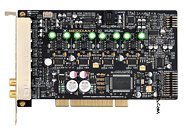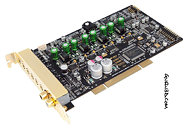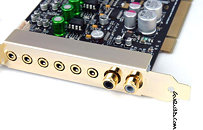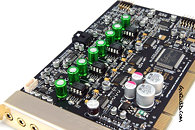Friday, July 23rd 2010

Auzentech X-Meridian Back With a Bang in New Second Generation Model
Widely regarded in the audiophile community as one of the best sound cards ever made, Auzentech's X-Meridian 7.1 is being revived in a new second-generation (2G) model. Following engagement with Creative for supply of its X-Fi chipsets, Auzentech had stopped production of the original X-Meridian 7.1 sound card citing shortages of the C-Media CMI8788 Oxygen HD chipset, which it now seems to have come over. The new X-Meridian 2G 7.1 from Auzentech sports the same CMI8788 Oxygen HD chip, backed by a squad of channel-independent enthusiast-grade AKM AK4396 DACs, user-replaceable OPAMP chips, high-end electrolytic capacitors to maintain natural-sounding output in the analogue portion of the card, and high-end solid-state capacitors for the power-distribution and digital output. To ensure the lowest latencies, the card uses the PCI interface, because CMI8788 is a PCI chip, and adding a PCI-E bridge chip would step up latencies. More technical details can be found in the exclusive preview by Guru3D.
Source:
Guru3D




57 Comments on Auzentech X-Meridian Back With a Bang in New Second Generation Model
Replace receiver with separate amps if you wish, but the point remains. To get good DACs in home audio, you have to spend much more than you should. You lose source selection with just bare amps tho.
EDIT: Fixed original post to make the scenario more clear.
Now instead of spending $700 on a digital receiver with a lesser-quality DAC than the ones on this card, you can spend $300 on an amplifier of the same amplifier circuit grade for better quality (since the DAC sitting on the sound card is better), or you can spend the same $700 on a better-quality amplifier for an even better output.
Then I bought a Onkyo TX-SR607 receiver with KEF KHT-3005SE speakers that are worth like 2500$ but got them for 1000$ + 5% Tax. Obviously optical on this would be better than analogue on Z-5500 but would had still been able to push the sound quality even further if I'd be able to use analogue on these speakers.. unfortunately I learned about the (Multi-Chanel 7.1 Analog output) severals months after and also learned none of the Onkyo have this so I sold my receiver to buy a Harman Kardon AVR-1600 at only 400$ which is almost the manufacturer's price and since I've been using my Auzentech Forte with this amp through analogue on my awesome KEF speakers, hell it sounds better than ever! Clearly worth every penny I've put into this setup.
What I hate from Auzentech is that they can't do a ****** card with everything on it. I wouldn't mind spending a premium price if I'd get the absolute best sound card but no they have to do for example:
1- Forte is the best for gaming. It's PCI-E and use the X-Fi chip with X-Ram.
2- Bravura doesn't have hardware acceleration, no X-Ram or X-Fi chip therefore clearly worse for gaming... BUT it let you switch all opamp instead of only the one for the headphone.
3- Now with this new card, it's not PCI-E and it's not hardware accelerated for gaming. To me it's like a enhanced Bravura in PCI version (-_-)
Why the **** couldn't they let us switch all opamp on the Forte too. Now either I get a "bad" chip for gaming but that let me change the opamp or else.. you see what I mean, I'm screwed no matter what I choose :banghead:
Like I said before, I'd rather buy a card that does everything well and really shines in audiophile applications rather than a card that only sounds good in games. I think that most of the people making comments about this card and who would ever think about throwing down this kind of money are looking for. Save your Creative fanboisms for another forum.
I understand we are in a thread talking about a sound card with good DAC but I thought I would mention that good outboard DACs are affordable.
Compare with a good set of IEMs or audiophile cans.
The forte shines as an audiophile card as well as a gaming card. It's a jack of all trades.
For most things, the Claro and Forte are equals, but the Forte uses less cpu, is cheaper, and is PCIe. The price difference puts them in 2 different markets, honestly.This. I use no effects other than EQ to level out the tonal characteristics of equipment and/or room. Also to sometimes compensate for poorly mixed/mastered tracks.Even if games aren't coded for it, check out Guru3d's reviews on cards. Xfi based cards still use significantly less CPU, even in Vista or 7.I was leaning towards surround setups. A preamp of that quality for a surround setup would cost 3x as much. I use only 2 channels for music, but I do still need surround for my games and movies. Somebody that does only 2 channel with no intention of going surround, and is looking for a sound card would be better served by a Xonar STX or similar.
Aka: I was exemplifying putting together the most versatile and "cheap" setup that is still of audiophile quality. And is very simple to set up.
I'll just keep my Auzentech Forte until Auzen wake up and make a card that both merge audiophile + gaming in mind in PCI-E... AND with all opamp swappable. Why gamers wouldn't want to swap them? It's completely ridiculous not being able to swap them on the Forte, Prelude or even the overpriced HTHD.
I've never heard the Crystalizer in action so I can't comment on that, but I prefer using no EQ's or effects - just the music as it was intended. Granted, EQ settings can compensate a bit when using inferior speakers/amplifiers or when speaker placement is restricted, but that's obviously not the ideal scenario.
Lastly, I'm not an audiophile, just a sound quality enthusiast I'd say, but I do spend a fair amount on sound (have a custom ~$1200 DLS SQ system in my car) and still don't think you'd be able to tell the difference between those two SNR's without some serious sound or I guess when listening to silence really loud... :rolleyes: